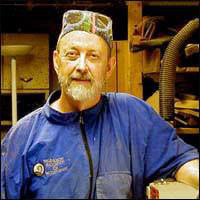Duplicating

by Phil Colson
Woodturner
It's been a while since I had a job turning from drawings. A customer needed lamp bases for her store. I
agreed to turn them. I went and got some poplar and came home to start the process. Two sets of two
bases and one singular base. Simple enough, x diameter, but they had to match. One matched a
base with a cove and the other was a duplicate of a metal base. The metal base design had to have a
glue up of two pieces of wood. All of this was rather straight forward. They each had to have a hole for
the lamp rod, a recess on the bottom for the nut and wire, and a horizontal hole drilled for the wire to go to
the plug. Simple enough, right? No, it was not so simple.
I put the wood on a
woodworm
and turned it round, then drilled
the recess in the bottom and sanded. I used spigot jaws on the chuck with a spacer to hold the bases by
the recesses, then drilled the top and sanded. I coated each with non wax shellac sealer. The bases will be
painted later.
I tell you all of this because it is harder than you think. If you want to improve your tool handling and
refine your eye, try duplicating an object from the house, whether it's a bowl, jar, or some sort of spindle, and make
several copies. No really, try it. You will be amazed at how it improves your turning technique. Every time I accept a job to do any architectural
work, I find it makes me a better turner.
Try it, it works for me.
Phil can be reached directly via email at
woodturnerphil@gmail.com.
Return to
The Highland Woodturner
front page
